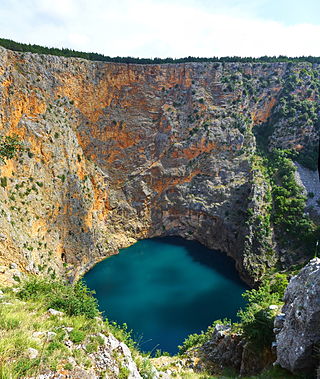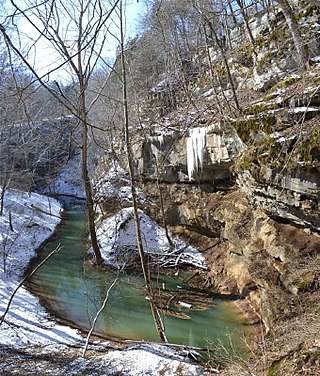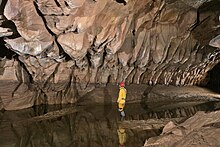
A cave or cavern is a natural void under the Earth's surface. Caves often form by the weathering of rock and often extend deep underground. Exogene caves are smaller openings that extend a relatively short distance underground. Caves which extend further underground than the opening is wide are called endogene caves.

Karst is a topography formed from the dissolution of soluble carbonate rocks such as limestone and dolomite. It is characterized by features like poljes above and drainage systems with sinkholes and caves underground. There is some evidence that karst may occur in more weathering-resistant rocks such as quartzite given the right conditions.

Limestone is a type of carbonate sedimentary rock which is the main source of the material lime. It is composed mostly of the minerals calcite and aragonite, which are different crystal forms of CaCO3. Limestone forms when these minerals precipitate out of water containing dissolved calcium. This can take place through both biological and nonbiological processes, though biological processes, such as the accumulation of corals and shells in the sea, have likely been more important for the last 540 million years. Limestone often contains fossils which provide scientists with information on ancient environments and on the evolution of life.

A stalactite is a mineral formation that hangs from the ceiling of caves, hot springs, or man-made structures such as bridges and mines. Any material that is soluble and that can be deposited as a colloid, or is in suspension, or is capable of being melted, may form a stalactite. Stalactites may be composed of lava, minerals, mud, peat, pitch, sand, sinter, and amberat. A stalactite is not necessarily a speleothem, though speleothems are the most common form of stalactite because of the abundance of limestone caves.

A sinkhole is a depression or hole in the ground caused by some form of collapse of the surface layer. The term is sometimes used to refer to doline, enclosed depressions that are also known as shakeholes, and to openings where surface water enters into underground passages known as ponor, swallow hole or swallet. A cenote is a type of sinkhole that exposes groundwater underneath. Sink, and stream sink are more general terms for sites that drain surface water, possibly by infiltration into sediment or crumbled rock.

A stalagmite is a type of rock formation that rises from the floor of a cave due to the accumulation of material deposited on the floor from ceiling drippings. Stalagmites are typically composed of calcium carbonate, but may consist of lava, mud, peat, pitch, sand, sinter, and amberat.

A speleothem is a geological formation made by mineral deposits that accumulate over time in natural caves. Speleothems most commonly form in calcareous caves due to carbonate dissolution reactions. They can take a variety of forms, depending on their depositional history and environment. Their chemical composition, gradual growth, and preservation in caves make them useful paleoclimatic proxies.

A cenote is a natural pit, or sinkhole, resulting when a collapse of limestone bedrock exposes groundwater. The term originated on the Yucatán Peninsula of Mexico, where the ancient Maya commonly used cenotes for water supplies, and occasionally for sacrificial offerings. The name derives from a word used by the lowland Yucatec Maya—tsʼonoʼot—to refer to any location with accessible groundwater.

Dolomite (also known as dolomite rock, dolostone or dolomitic rock) is a sedimentary carbonate rock that contains a high percentage of the mineral dolomite, CaMg(CO3)2. It occurs widely, often in association with limestone and evaporites, though it is less abundant than limestone and rare in Cenozoic rock beds (beds less than about 66 million years in age). One of the first geologists to distinguish dolomite from limestone was Déodat Gratet de Dolomieu, a French mineralogist and geologist after whom it is named. He recognized and described the distinct characteristics of dolomite in the late 18th century, differentiating it from limestone.

Flowstones are sheetlike deposits of calcite or other carbonate minerals, formed where water flows down the walls or along the floors of a cave. They are typically found in "solution caves", in limestone, where they are the most common speleothem. However, they may form in any type of cave where water enters that has picked up dissolved minerals. Flowstones are formed via the degassing of vadose percolation waters.

Gongshi, also known as scholar's rocks or viewing stones, are naturally occurring or shaped rocks which are traditionally appreciated by Chinese scholars. The term is related to the Korean suseok (수석) and the Japanese suiseki (水石).

Glaciokarst is a geological term that refers to a specific type of karst landscape that has been influenced significantly by past glacial activity.

In geology, boxwork is defined as a honeycomb-like structure that can form in some fractured or jointed sedimentary rocks. If the fractures in the host rock are mineralized, they can become more resistant to weathering than the surrounding rock, and subsequent erosion can produce boxwork structures. In mining geology, boxwork is a set of (typically) quartz-lined cavities, retaining the shape of the dissolved ore minerals, in gossans. In classical geology or mineralogy these mineral casts would not be called boxwork, but would instead be called pseudomorphs, or epimorphs. In cave geology, boxwork is an uncommon type of mineral structure, or speleogen, occasionally found in caves and erosive environments.

A blue hole is a large marine cavern or sinkhole, which is open to the surface and has developed in a bank or island composed of a carbonate bedrock. Blue holes typically contain tidally influenced water of fresh, marine, or mixed chemistry. They extend below sea level for most of their depth and may provide access to submerged cave passages. Well-known examples are the Dragon Hole and, in the Caribbean, the Great Blue Hole and Dean's Blue Hole.
Speleogenesis is the origin and development of caves, the primary process that determines essential features of the hydrogeology of karst and guides its evolution. It often deals with the development of caves through limestone, caused by the presence of water with carbon dioxide dissolved within it, producing carbonic acid which permits the dissociation of the calcium carbonate in the limestone.
A salt cave is a cave formed within rock salt by dissolution of this very soluble rock by water. As with other soluble rocks, a distinctive set of landscape features can arise from the solutional process; in this case it is known as salt karst or 'halite karst'. The three key areas of salt karst are those in Iran, Israel and Spain, together with an example in Romania. Malcham cave in Israel is the longest salt cave in the world with a measured length of over 10km. It is located at Mount Sodom. There are significant salt caves on Qeshm Island in Iran including Tri Nahacu Cave and Namakdan Cave. This cave was listed in October 2022 by the International Union of Geological Sciences in their 'First 100 IUGS Geological Heritage Sites' as being of global significance for the understanding of tectonics and ongoing geological processes. Amongst the caves developed within the several salt karsts in Spain are Cova dels Meandres de Sales which at 4.3km in length is the world's third longest. The fourth longest is Pestera 6S de la Mânzălesti, in România, at 3.1km in length.

A solutional cave, solution cave, or karst cave is a cave usually formed in the soluble rock limestone. It is the most frequently occurring type of cave. It can also form in other rocks, including chalk, dolomite, marble, salt beds, and gypsum.
There are a number of terms that are used in connection with caves, caving and speleology. The following is an incomplete list.

Cedar Sink is a vertical-walled large depression or sinkhole in the ground, located in Edmonson County, Kentucky and contained within and managed by Mammoth Cave National Park. The sinkhole measures 300 feet (91.4
Scalloping is a particular form of sculpting of the walls of limestone caves through dissolution by turbulently flowing water containing dissolved carbon dioxide. Individual scallops are shallow concave features found on many cave surfaces which are or have at some time been in prolonged contact with a water current. They typically occur in large numbers abutting one another, entirely coverings sections of cave passage, and can vary in size from less than a centimetre to many tens of centimetres or more. Their size is in inverse proportion to the speed of the current in which they formed; smaller scallops imply faster flow, larger scallops imply slower flow.














